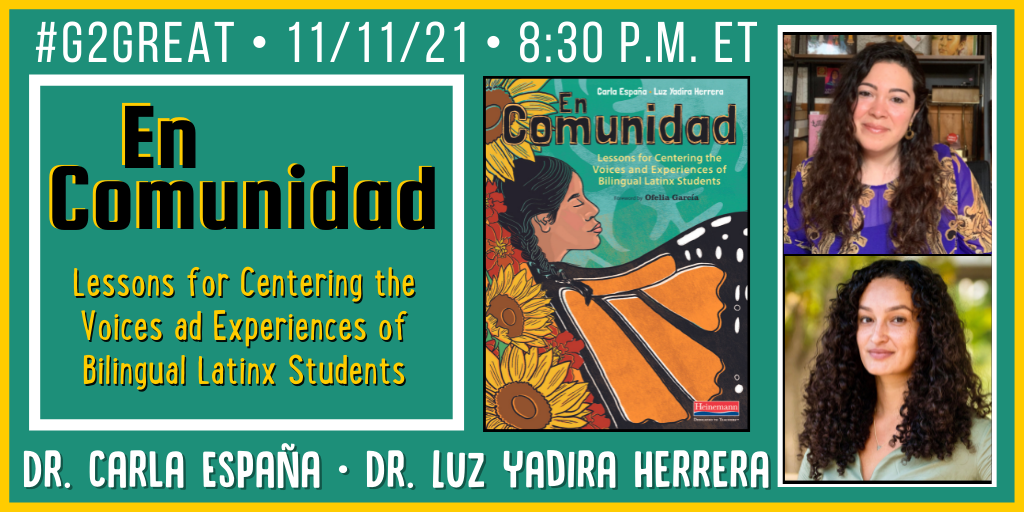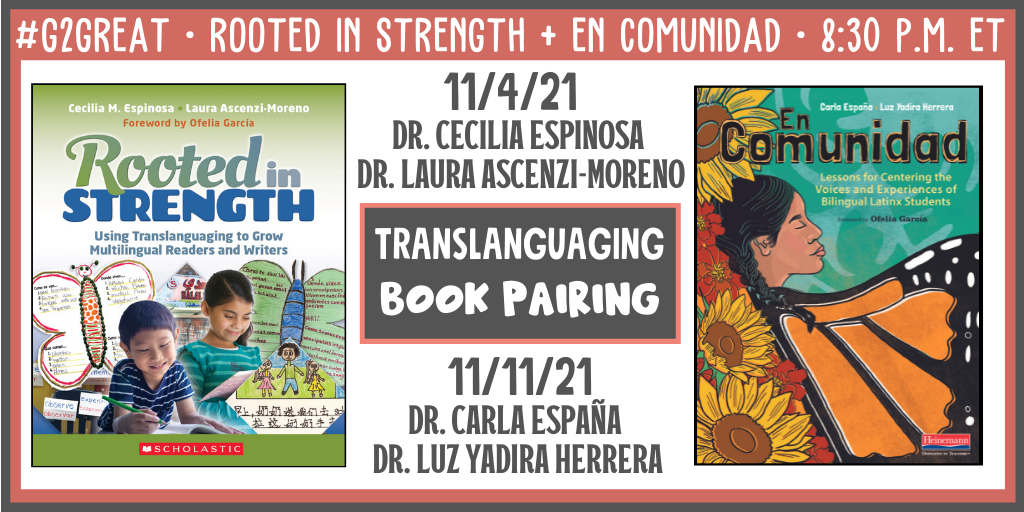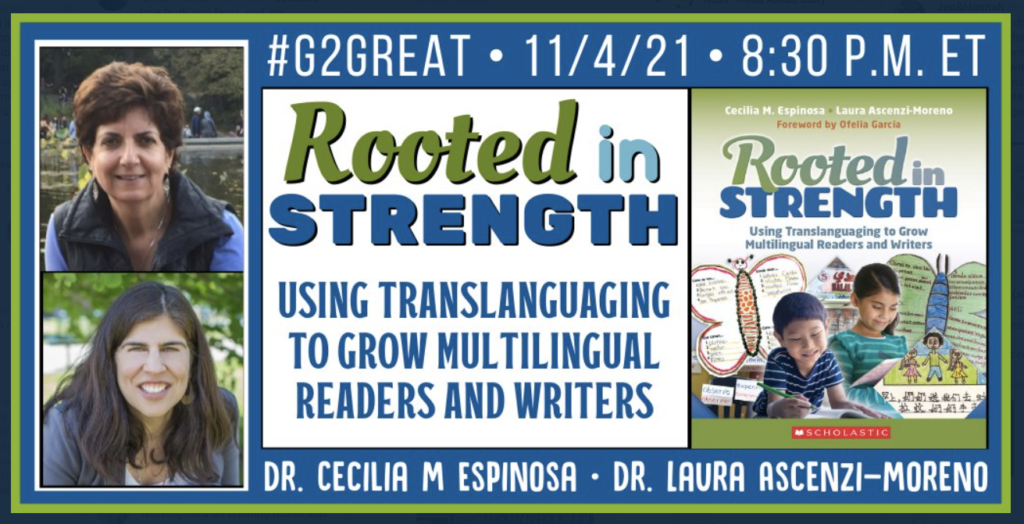by Jenn Hayhurst

On November 11, 2021 #G2Great welcomed Dr. Carla España and Dr. Luz Yadira Herrera to continue our conversation about translanguaging, with their new book, En Comunidad Lessons for Centering the Voices and Experiences of Bilingual Latinx Students.
What motivated you to write this book? What impact did you hope that it would have in the professional world?
We started our teaching journey in NYC public schools with bilingual and multilingual students across monolingual and bilingual programs. Most of the professional development workshops, curricula, and texts for children were in English. There were many professional texts with strategies for “ELLs” and we had a problem with the deficit framing of children who were already navigating multiple languages, cultures, and schooling. Our questions and concerns took us to develop research studies on teaching with bilingual and multilingual students. Our dissertation advisor, Ofelia García recommended we write together and so we did! We were motivated by our own experiences with learning English while developing our Spanish, our teaching, and our research. We were motivated by our families’ resolve and support that were crucial in making sure we had the connections with them and our language practices. consider the problem when we center on white, monolingual, dominant language practices.
We hope this book also opens doors for other bilingual and multilingual educators to write about their teaching experience, with support from publishers.
Dr. Carla España and Dr. Luz Yadira Herrera (11/11/21)
Knowing where you are on your teaching journey is really important for us all. I have had the benefit of years of professional learning and practical experiences that have made me the teacher I am today. I love teaching children to be curious about words, how to read, and how to write. I love making them feel important and wise. I am crystal clear as to why I am a teacher and I actively work at understanding my role in today’s educational landscape. For me, an educator working and living on Long Island NY, the context of that landscape has been shaped by a recent report from the LEAD Coalition showing that multilanguage learners in New York schools (many of whom live on Long Island) has grown 20 percent over the past 10 years.
That’s a fact, and speaking anecdotally, I find I am working with more children who are bilingual or are beginners to learning English altogether. What can I do to be responsive to these students? I believe my power is unlocked by becoming unabashedly self-aware. I need to learn more about them and their needs. I am a monolingual teacher who is diving into learning more about translanguaging:
Translanguaging is when a multilingual person’s full linguistic repertoire is used and honored, instead of trying to keep narrowly focused on a single language.
What is Translanguging? Heinemann Blog featuring Dr. Carla España & Dr. Luz Yadira Herrera

It occurs to me that I have a lot in common with many of my students who are new to learning English. When it comes to having an understanding for translanguaging I am a beginner too. In that spirit I write this post adopting a beginner’s mindset.
Following Students to Learn More
Intentional Teaching
Embracing the Process to Grow My Practice
What are your BIG takeaways from your book that you hope teachers will embrace in their teaching practices?
We begin our book with a Critical Bilingual Literacies framework that informs the lesson sequences. We hope that teachers will embrace a CBL framework as a way to grow in their planning and teaching.
Constantly self-reflect on language ideologies while engaging with texts, classroom experiences, and research on bilingual practices.
Practice a pedagogy that focuses on all participants’ “unlearning” the notions of linguistic supremacy that uphold Eurocentric notions/ racialized language hierarchies (Alim and Smitherman 2012).
Analyze linguistic practices, literacies, and power.
Celebrate bilingual Latinx linguistic practices and plan content (curriculum, texts) and methods from the perspective of the bilingual learner.
Dr. Carla España and Dr. Luz Yadira Herrera (11/11/21)
After spending an evening with Dr. Carla España and Dr. Luz Yadira Herrera (and all of the #G2Great PLN) I have strengthened my resolve to continuing to learn more about translanguaging and to put that learning to practical use:
- I am going to learn from my students, by letting them lead the way so I may learn more about them.
- I am going to continue my work as an intentional teacher who uses what I am reading in professional texts and my classroom experiences to plan for the future
- I am going to embrace where I am right now in this learning process while continuing to grow my practice for the future.
We at #G2Great believe it is every teacher’s mission to continue to strive for greatness. We believe that our work is never done because when you strive to know more, to be better than you were the day before that means pushing ourselves to look for our blindspots. On that note, I’d like to end this post with Dr. Carla España and Dr. Luz Yadira Herrera words.
What is a message from the heart you would like for every teacher to keep in mind?
This is life work. As much as we love supporting teachers with curriculum development, sharing frameworks for teaching and planning lessons that center bilingualism and multilingualism, there is still some deep processing of our own ideas about language learning and minoritized languages that we cannot ignore. There is a lot of unlearning we must confront, especially as many of us are products of systems that have propagated myths and harmful ideas about bilingualism, multilingualism, and the Latine community. Our book is a way for us to welcome teachers to join our conversation and to be in this journey in community with us.
Dr. Carla España and Dr. Luz Yadira Herrera (11/11/21)
To learn more please visit these link:
On the Heinemann Podcast: Translanguaging in Poetry with Carla España and Luz Yadira Herrera
Six Essential Practices to Center the Voices and Experiences of Latinx Students in the Classroom

